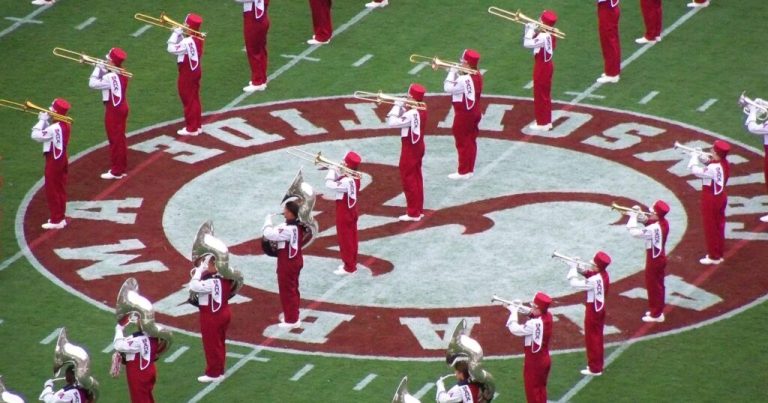Reviewed by: Nathan Watson
Longtime Principal Van Phillips explains why high school sports in Alabama succeed
Reading time: 6 minutes
Sponsored

Break out the cake and candles—the Alabama High School Athletic Association is celebrating its 100th anniversary.
When an organization hits the century mark, it begs the question: How did they do it?
We asked Alabama High School Athletic Association’s (AHSAA) Board President and Center Point Principal Van Phillips that very question, and his answers may surprise you.
“The Alabama High School Athletic Association was formed because principals got together and said, we need a governing body to oversee athletics in the state of Alabama,” Phillips explained. “It was 100 years ago when they came together to foster what we now know as AHSAA. After the merger with the Alabama Interscholastic Athletic Association in 1968, which was the black high school athletic association, we built one of the most respected athletic associations in the country.”
It may not be flashy or flamboyant to say these days, but Phillips credits the organization’s structure, bylaws and rules as the reason for the success of AHSAA.
“We are a national model for state athletic associations throughout the country,” added Phillips. “From the beginning, they established common sense rules, sportsmanship and fair play. That’s what has been our mission.”
Principals Are Empowered

If there is one individual who embodies the spirit of high school athletics in Alabama, it is Center Point High School’s Principal Phillips. A Birmingham native, he was a classmate of the late Frank Warren, the former Auburn Football All-American whose AHSAA shot-put and discus state record stood for 35 years.
Phillips played seven sports, graduated Phillips High School in 1978 and earned an athletic scholarship from Kentucky State University. He returned to Birmingham to teach, and for the past three decades, he has been a principal in the Jefferson County School System. He rose through the ranks of the AHSAA, becoming President of the Board of Control.
Phillips identified three ways the AHSAA sets itself apart from other associations.
First, he told us in most cases, good or bad, the principal is ultimately responsible for athletic programs. It is why they need to know the bylaws and rules.
“It’s been my experience as a principal for 30 years that people are concerned about ACT scores, and they are concerned about accountability. But you let something go awry with the athletic program, it gets on the news — it stirs the community up much faster than anything else that relates to our job as a principal. It’s why I try to get young men and young women who become principals to fully engulf themselves with the rules and the bylaws of the Alabama High School Athletic Association.”
Within the AHSAA, principals know they have a voice.
The structure of the organization guarantees it.
Schoolhouse Rock—AHSAA style

The second way AHSAA excels is how it accepts bylaw and rule changes.
Remember Schoolhouse Rock on Saturday morning about government and bills becoming law? Here is how AHSAA is governed.
According to the AHSAA Constitution and By-laws, schools are divided into eight districts across the state. Everyone has one vote. A 1A school like Sweet Water in Marengo County, which has a couple of dozen seniors graduating each year, has the same representation as the largest school in Alabama — Auburn High School.
AHSAA’s legislative process is open and democratic. If a school wants to change a rule, schools are encouraged to write a proposal—as long as it is endorsed by the local principal to go into a proposal sheet, which is similar to a ballot. Then the proposal is sent out for a survey vote among all schools. The Legislative Council, composed of 32 representatives – four members elected by each of the eight districts – then meet to discuss and vote on the proposals using the schools’ survey vote as a guide. If a proposal garners a two-thirds positive vote from the Legislative Council, it becomes a by-law.
The Central Board of Control is then charged with enforcing the by-law. The CBOC does have final say in matters concerning championship play that affect the AHSAA member schools as it relates to athletics.
Every January, AHSAA accepts proposals. Contact your local school principal for their guidance and support if you have one.
Serving the Membership

The third example — AHSAA supports its member schools by waiving their annual memberships fees. This has been done for three consecutive decades – since 1991 – for the last 32 years. That’s a savings of approximately $90,000 a year to the schools. That’s right — a $2.4 million savings for AHSAA’s high schools, junior and middle schools over the last 32 years. And it is not just membership fees.
As reported by Bham Now in December, since the revenue share program was initiated in 2009, AHSAA has also given an additional $19.2 million back to member schools through the revenue share program. This total is in addition to the stipends schools receive from participating in the AHSAA state playoffs in the various sports.
This stands out nationally because this particular revenue share initiative is recognized as the first program of its kind in the National Federation of High School Association (NFHS) for high school state associations. In fact, even though it has been copied elsewhere by other state high school athletic associations, no other state association contributes an amount of this magnitude back to its member schools through revenue sharing.
100 Years

Beyond the organizational structure, by-laws and rules — the opportunity to serve and enrich the lives of student-athletes, families and communities is what makes the AHSAA all worth it.
“It’s a humbling experience for me,” said Phillips, who is retiring later this school year. “I was just a kid who grew up in the Norwood and Fountain Heights neighborhoods and wanted the opportunity to compete. Now as president of the Board for the last couple of years, I’ve gotten an opportunity to help take our association to new heights in the next 100 years.”



